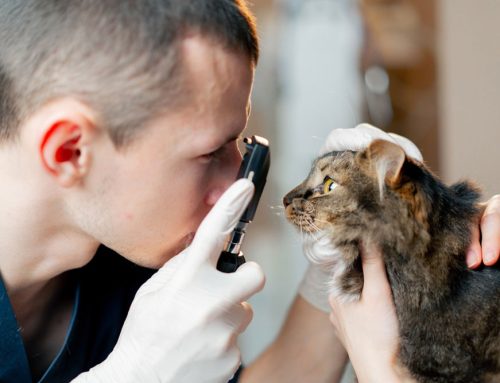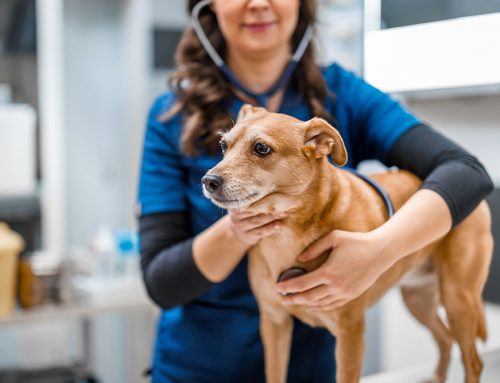If you neglect your pet’s dental health, the ensuing periodontal disease could lead to serious health issues. Poor dental hygiene is not only a problem for older pets. Eighty-five percent of pets exhibit periodontal disease by age 3. The sooner you start addressing your pet’s oral health, the easier the process will be for you and them. Our team at Wales Animal Clinic wants to explain why dental hygiene is important for your pet and provide tips to help you properly care for their teeth.
How can poor dental hygiene affect my pet?
Normally, your pet’s teeth are bathed in saliva, bacteria, and food particles (i.e., plaque). If their teeth are not regularly brushed, the plaque mineralizes to tartar, a gritty, solid material that blocks oxygen absorption by the outer tooth. This development allows bacteria to grow around the tooth. The bacteria cause an inflammatory process in the surrounding tissues, and, if not addressed appropriately, this inflammation can destroy the tooth’s attachment. This can result in your pet losing their teeth. As the inflammation worsens, the jawbone can also be affected, leading to fracture or disintegration. Toy breeds are at higher risk for severe jawbone issues. The bacteria in your pet’s mouth can also spread to other areas, such as the heart, liver, and kidneys, causing infection in these organs.
How do regular professional cleanings help my pet?
Your pet’s mouth should be evaluated by a veterinary professional at least once a year. One of our experienced veterinarians can perform a thorough oral exam. X-rays also may be required to assess your pet’s tooth roots and jaw. A detailed dental cleaning will be performed with your pet under general anesthesia. All dental plaque and tartar will be removed, all teeth will be checked for looseness and fractures, and the tooth enamel will be polished to correct any unevenness left by tartar removal. Notes will be made on a dental chart, detailing any abnormalities observed in your pet’s mouth.
How can I keep my pet’s teeth healthy between professional cleanings?
Dental care should be a regular part of your pet’s grooming routine. Brushing after every meal is ideal, but three to four times a week is adequate. How do you actually brush your pet’s teeth?
- Handle their mouth — Start handling your pet’s mouth to get them comfortable with the process. The younger they are when you start this activity, the easier they will acclimate. Rub your finger around their gums and their teeth, move their lips to expose their teeth, and gently open their mouth by placing your hands on their muzzle and lower jaw. Initially, you can put peanut butter on your finger to make them see the exercise as an enjoyable experience.
- Choose an appropriate toothbrush — Pet toothbrushes are smaller and fit your pet’s mouth better than regular toothbrushes. Introduce the brush to your pet and let them sniff and chew on it. Gently rub the outer surface of the visible teeth.
- Choose an appropriate toothpaste — Never use human toothpaste to brush your pet’s teeth. They will not spit out the foam, and the ingredients could cause gastrointestinal upset if ingested. Pet toothpastes come in various flavors, such as poultry, meat, and seafood, making them a treat for your pet. Offer your pet a small taste of a pet-appropriate toothpaste. If they seem to like the flavor, put a small amount on the toothbrush, and gently start brushing their teeth in a circular motion.
- Brush along the gumline — Ensure you brush along the gumline to remove plaque from this area. Gradually increase the number of teeth you brush each day until your pet is comfortable with the procedure. Once they are comfortable with you brushing their visible teeth, open their mouth and begin brushing the teeth in the back of their mouth. You only need to brush the outer part of the tooth since the inner surface is cleaned by saliva.
If your pet won’t tolerate having their teeth brushed, try dental wipes to remove plaque deposits from the surface of their teeth. This process is not as effective as brushing, but it’s better than not removing the plaque. Remember, too, that while at home care is important for your pet’s dental health, it does not take the place of a professional veterinary cleaning.
What other steps can I take to improve my pet’s dental health?

Feeding your pet dry kibble can help scrape away some dental plaques, but some pets require wet food. Always consult your veterinary professional before changing your pet’s diet. Dental treats are also a great way to improve your pet’s dental health, and they often contain ingredients to freshen your pet’s mouth. Choose treats approved by the Veterinary Oral Health Council to ensure they are effective at removing plaque and tartar. Dental chews can be helpful, too, in removing plaque and tartar. Choose chews that are not hard to prevent tooth fractures.
Your pet’s dental hygiene can easily be maintained, and the process can be a great bonding time for you and your pet. If your pet is due for their annual dental evaluation, do not hesitate to contact our team at Wales Animal Clinic to schedule an appointment.







Leave A Comment